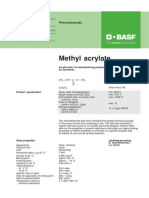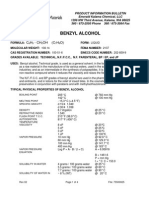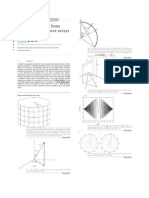TI - CP - 1352 - e - 2-Ethylhexyl Acrylate - 190419 - SCREEN - 02
TI - CP - 1352 - e - 2-Ethylhexyl Acrylate - 190419 - SCREEN - 02
Uploaded by
李承興Copyright:
Available Formats
TI - CP - 1352 - e - 2-Ethylhexyl Acrylate - 190419 - SCREEN - 02
TI - CP - 1352 - e - 2-Ethylhexyl Acrylate - 190419 - SCREEN - 02
Uploaded by
李承興Original Title
Copyright
Available Formats
Share this document
Did you find this document useful?
Is this content inappropriate?
Copyright:
Available Formats
TI - CP - 1352 - e - 2-Ethylhexyl Acrylate - 190419 - SCREEN - 02
TI - CP - 1352 - e - 2-Ethylhexyl Acrylate - 190419 - SCREEN - 02
Uploaded by
李承興Copyright:
Available Formats
Technical Information Petrochemicals
TI/CP 1352 e
October 2017 Page 1 of 2
Supersedes edition dated April 2016
2-Ethylhexyl acrylate
Acrylic ester for manufacturing polymers and for use as a feedstock
for syntheses.
CH2 = CH–C–O–CH2–CH–(CH2)3–CH3 CAS No.: 103-11-7
EINECS No.: 203-080-7
O CH2–CH3
C11H20O2 Molar mass: 184.3
Product specification
Assay (Gas chromatography) min. 99.6 %
Water content (ASTM E 203) max. 0.05 %
Acid content (calc. as acrylic acid) max. 0.009 %
(ASTM D 1613)
Color on despatch (APHA, ASTM D 1209)
Standard stabilization (HPLC BASF or max. 10
ASTM D 3125) 15 ± 5 ppm MEHQ
The aforementioned data shall constitute the agreed contractual quality
of the product at the time of passing of risk. The data are controlled at
regular intervals as part of our quality assurance program. Neither these
data nor the properties of product specimens shall imply any legally binding
guarantee of certain properties or of fitness for a specific purpose and
no liability of ours can be derived therefrom.
Other properties Labelling according
to Local Directives
Appearance clear, colorless see MSDS
Physical form liquid
Odor sweet
Density at 20 °C 0.885 g/cm3
Refractive index nd at 20 °C 1.435
Boiling point at 1013 mbar 216 °C
Boiling point at 13 mbar 91 °C
Freezing point approx. – 90 °C
Viscosity
at 0 °C 2.9 mPa ∙ s
at 20 °C 1.7 mPa ∙ s
at 40 °C 1.2 mPa ∙ s
Specific heat of liquid 1.89 kJ/kg °C
Heat of evaporation at 248 kJ/kg
boiling point
Heat of polymerization approx. 332 kJ/kg
Vapor pressure
at 20 °C 0.1 mbar
at 50 °C 1.2 mbar
at 100 °C 19.8 mbar
Temperature rating for electrical T 3 (200 – 300 °C)
equipment
TI/CP 1352 e October 2017 Page 2 of 2 2-Ethylhexyl acrylate
Applications 2-Ethylhexyl acrylate forms homopolymers and copolymers. Copolymers of
2-Ethylhexyl acrylate can be prepared with acrylic acid and its salts, amides
and esters, and with methacrylates, acrylonitrile, maleic acid esters, vinyl
acetate, vinyl chloride, vinylidene chloride, styrene, butadiene, unsaturated
polyesters and drying oils, etc. 2-Ethylhexyl acrylate is also a very useful
feedstock for chemical syntheses, because it readily undergoes addition
reactions with a wide variety of organic and inorganic compounds.
Storage & Handling In order to prevent polymerization, 2-Ethylhexyl acrylate must always be
stored under air, and never under inert gases. The presence of oxygen is
required for the stabilizer to function effectively. It has to contain a stabilizer
and the storage temperature must not exceed 35 °C. For extended storage
periods over 4 weeks it is advisable to replenish the dissolved oxygen
content. Under these conditions, a storage stability of one year can be
expected. In order to minimize the likelihood of overstorage, the storage
procedure should strictly follow the “first-in-first-out” principle.
Storage tanks and pipes should be made of stainless steel or aluminium.
Although 2-Ethylhexyl acrylate does not corrode carbon steel, there is a risk
of contamination if corrosion does occur.
Storage tanks, pumps and pipes must be earthed. For more detailed infor-
mation please consult also the brochure “SAFE HANDLING AND STORAGE
OF ACRYLIC ESTERS” of EBAM.
Safety A Material Safety Data Sheet has been compiled for 2-Ethylhexyl acrylate
that contains up-to-date information on all questions relevant to safety.
Note The data contained in this publication are based on our current knowledge
and experience. In view of the many factors that may affect processing
and application of our product, these data do not relieve processors from
carrying out their own investigations and tests; neither do these data imply
any guarantee of certain properties, nor the suitability of the product for
a specific purpose. Any descriptions, drawings, photographs, data, pro-
portions, weights etc. given herein may change without prior information
and do not constitute the agreed contractual quality of the product. It is
the responsibility of the recipient of our products to ensure that any
proprietary rights and existing laws and legislation are observed.
October 2017
BASF SE
Operating Division Petrochemicals
Regional Business Unit Industrial Petrochemicals Europe
67056 Ludwigshafen, Germany
Visit us online at http://www.acrylicmonomers.basf.com
You might also like
- Excel Containment SizingDocument7 pagesExcel Containment SizingAbraham JyothimonNo ratings yet
- CST 363 - Final Project Part 1Document3 pagesCST 363 - Final Project Part 1api-477205223No ratings yet
- Butyl Acrylate: Technical Information PetrochemicalsDocument2 pagesButyl Acrylate: Technical Information PetrochemicalsA ANo ratings yet
- TI CP 1327 e Methyl Acrylate 190419 SCREEN 01Document2 pagesTI CP 1327 e Methyl Acrylate 190419 SCREEN 01Vallen ChemNo ratings yet
- 2-Hydroxyl Ethyl Acrylate - HEA - BASFDocument2 pages2-Hydroxyl Ethyl Acrylate - HEA - BASFJimenez JMNo ratings yet
- 2-Hydroxyl Ethyl Acrylate - HEA - JAMORINDocument2 pages2-Hydroxyl Ethyl Acrylate - HEA - JAMORINJimenez JMNo ratings yet
- Butyl Acrylate: Technical Information June 2013Document2 pagesButyl Acrylate: Technical Information June 2013killer120No ratings yet
- Ti 2020 IbaDocument3 pagesTi 2020 Ibawilfred gomezNo ratings yet
- TI CP 1593 e Acrylic Acid Glacial 190419 SCREEN 01Document3 pagesTI CP 1593 e Acrylic Acid Glacial 190419 SCREEN 01Md. Anamul HaqueNo ratings yet
- Atbc Ficha TécnicaDocument2 pagesAtbc Ficha TécnicadanielaNo ratings yet
- 2-Ethylhexyl Acrylate: Technical Information PetrochemicalsDocument2 pages2-Ethylhexyl Acrylate: Technical Information PetrochemicalsnurparinNo ratings yet
- TI - CP - 2342 - e - 2-EHMA F - 2016 - 09Document2 pagesTI - CP - 2342 - e - 2-EHMA F - 2016 - 09Siddhant HabbuNo ratings yet
- Stearyl Acrylate (SA 18 BASF)Document2 pagesStearyl Acrylate (SA 18 BASF)Rashid SaleemNo ratings yet
- Tert Butyl Acrylate (BASF)Document2 pagesTert Butyl Acrylate (BASF)Mario RollanoNo ratings yet
- Acrylic AcidDocument4 pagesAcrylic AcidDita NainggolanNo ratings yet
- Mek Eu 26Document3 pagesMek Eu 26Jeisson_Zapata_547No ratings yet
- Basf Bea 1822 F 2016 09Document2 pagesBasf Bea 1822 F 2016 09AllanNo ratings yet
- Smds Del WATER STANDARD 1Document3 pagesSmds Del WATER STANDARD 1HectoerNo ratings yet
- Lyondellbasell Chemicals Technicalliterature Glycol Ether Pma Technical Datasheet 2255Document3 pagesLyondellbasell Chemicals Technicalliterature Glycol Ether Pma Technical Datasheet 2255gouravNo ratings yet
- BASF E-CPI 1016e ButyltriglycolDocument3 pagesBASF E-CPI 1016e ButyltriglycolsimphiweNo ratings yet
- Pala 652 e 02 15Document3 pagesPala 652 e 02 15Carmen LinaresNo ratings yet
- BASF TDS - 1016g - Butyl Triglycol - Oct 2021Document2 pagesBASF TDS - 1016g - Butyl Triglycol - Oct 2021Hamada HamadaNo ratings yet
- Asam Akrilat GlasialDocument2 pagesAsam Akrilat GlasialErwin Tallu SangrapuNo ratings yet
- 2-Ethylhexyl Acrylate: Technical Data SheetDocument4 pages2-Ethylhexyl Acrylate: Technical Data Sheetfake77100% (1)
- Technical Data SheetDocument3 pagesTechnical Data SheetEmanuel TescheNo ratings yet
- Pds Trigonox 21 c50 Acrylics Production Nar enDocument3 pagesPds Trigonox 21 c50 Acrylics Production Nar enJared CruzNo ratings yet
- Bpxe 9Q932NDocument2 pagesBpxe 9Q932NArthur Sanda LayukNo ratings yet
- Product Description and Handling Guide Methyl AcetateDocument7 pagesProduct Description and Handling Guide Methyl AcetateLuna ArboledaNo ratings yet
- Diethylenetriamine DetaDocument2 pagesDiethylenetriamine DetajangreeNo ratings yet
- Kanatol 800Document2 pagesKanatol 800shubham jodmoteNo ratings yet
- Vestamin IPD e PDFDocument3 pagesVestamin IPD e PDFEldhose ChackochanNo ratings yet
- Cab 551-02Document3 pagesCab 551-02optimus_1404No ratings yet
- Pds Trigonox A w70 Pharmaceutical Industry Glo enDocument3 pagesPds Trigonox A w70 Pharmaceutical Industry Glo enAhmed HosniNo ratings yet
- A541-Ccag Aoc Eco TekDocument2 pagesA541-Ccag Aoc Eco TekHemmingsNo ratings yet
- Deta - TDS Dow PDFDocument2 pagesDeta - TDS Dow PDFAlexander JuanNo ratings yet
- Aircol SN RangeDocument2 pagesAircol SN RangecarmaNo ratings yet
- Technical Data Sheet TexanolDocument4 pagesTechnical Data Sheet TexanolRICHARD ODINDONo ratings yet
- Deh 24 (Teta)Document6 pagesDeh 24 (Teta)sriatul2006No ratings yet
- Caradol Ed28-200Document2 pagesCaradol Ed28-200Yunus KurtNo ratings yet
- ATBCDocument2 pagesATBCmurteza semanNo ratings yet
- ETHYLENEAMINE E-100 (E-100) : Technical BulletinDocument2 pagesETHYLENEAMINE E-100 (E-100) : Technical BulletinRAFAEL MIERESNo ratings yet
- Su enDocument2 pagesSu enAngqy TamowangkayNo ratings yet
- TDS 2010 Emuldac AS-25-SC November 2012Document2 pagesTDS 2010 Emuldac AS-25-SC November 2012Atia DjihadNo ratings yet
- Kanatol 2MDocument2 pagesKanatol 2Mbhalchandra2290876No ratings yet
- Aral Antifreeze Silikatfrei Global English PDB 456112Document2 pagesAral Antifreeze Silikatfrei Global English PDB 456112Техник СвязиNo ratings yet
- Aeea TDS PDFDocument2 pagesAeea TDS PDFMannar1No ratings yet
- Benzyl AlcoholDocument4 pagesBenzyl AlcoholLaxman1809No ratings yet
- Isopropanol S1111 TDS - 10-3-2016Document3 pagesIsopropanol S1111 TDS - 10-3-2016agarwalashwin32No ratings yet
- PDS 2-Ethylhexanol Eng-2121Document2 pagesPDS 2-Ethylhexanol Eng-2121Raira San JoseNo ratings yet
- Aqualink 300F Ver2Document2 pagesAqualink 300F Ver2Georgina SuleNo ratings yet
- Absolac 120HR: Acrylonitrile Butadiene Styrene (ABS)Document2 pagesAbsolac 120HR: Acrylonitrile Butadiene Styrene (ABS)Vinoth SekarNo ratings yet
- GL XX Marcol 82Document3 pagesGL XX Marcol 82angel de mi guardaNo ratings yet
- Perfecto TR UN BPXE-9Z8VBQDocument2 pagesPerfecto TR UN BPXE-9Z8VBQRNo ratings yet
- Arakril Ak 840Document2 pagesArakril Ak 840decopinturas rdNo ratings yet
- Caradol Et 160 01 2019Document2 pagesCaradol Et 160 01 2019Yunus KurtNo ratings yet
- Shellsol 2046 Ar: Technical DatasheetDocument3 pagesShellsol 2046 Ar: Technical DatasheetJavier Godoy MirandaNo ratings yet
- L-QB 300 Synthetic Heat Transfer Oil For Roller MillDocument3 pagesL-QB 300 Synthetic Heat Transfer Oil For Roller Millmd-ariful.islamNo ratings yet
- Technical Data Sheet: ApplicationsDocument2 pagesTechnical Data Sheet: ApplicationsJuan Sebastián Fernández RamírezNo ratings yet
- KANATOL - 1001: Di Iso Decyl Phthalate (Didp) Primary Plasticizer For PVC and PVC CopolymersDocument2 pagesKANATOL - 1001: Di Iso Decyl Phthalate (Didp) Primary Plasticizer For PVC and PVC Copolymerssriatul2006No ratings yet
- KANATOL - 400 (I) : Di Iso Butyl Phthalate (Dibp) Primary Plasticizer For PVC and PVC CopolymersDocument2 pagesKANATOL - 400 (I) : Di Iso Butyl Phthalate (Dibp) Primary Plasticizer For PVC and PVC CopolymersAhmedNo ratings yet
- Ecg - 100GDocument29 pagesEcg - 100GeryNo ratings yet
- Standard Test Methods CFFADocument43 pagesStandard Test Methods CFFAAmparo Mejia RuizNo ratings yet
- Excel 2016 Charts and GraphsDocument38 pagesExcel 2016 Charts and GraphsHattari AyoubNo ratings yet
- Trumpet PedagogyDocument9 pagesTrumpet PedagogyRichy SegarraNo ratings yet
- Design Calculations Steel Wire and CradleDocument2 pagesDesign Calculations Steel Wire and CradleRanjit S KashyapNo ratings yet
- Unit 1Document86 pagesUnit 1abhishekNo ratings yet
- Unit Testing - AH01: Application Area - PPDocument35 pagesUnit Testing - AH01: Application Area - PPBhattahcarjee RupakNo ratings yet
- Physical Properties of WaterDocument4 pagesPhysical Properties of Waternicole bNo ratings yet
- Scale SampleDocument563 pagesScale SampledarebertNo ratings yet
- Acoustic Radiation From Cylindrical ArraysDocument2 pagesAcoustic Radiation From Cylindrical Arraysd00brightNo ratings yet
- Impulse and MomentumDocument32 pagesImpulse and MomentumROBERT C. MAGPILY JR.No ratings yet
- Avo 01-M3 and 4 Practical-Group 1Document32 pagesAvo 01-M3 and 4 Practical-Group 1Lawrence LawrenceNo ratings yet
- 11 Algebra 2 Tutor Multiply and Divide Radical ExpressionsDocument30 pages11 Algebra 2 Tutor Multiply and Divide Radical Expressionsashfaq shaik extraNo ratings yet
- PHYSICS - 10 First Term ExaminationDocument11 pagesPHYSICS - 10 First Term ExaminationFatima MohammadNo ratings yet
- Forces ProblemsDocument4 pagesForces ProblemsJan DefrNo ratings yet
- GCSE Maths Revision Factorising Quadratics (Double Brackets - x2 + BX + C) WorksheetDocument6 pagesGCSE Maths Revision Factorising Quadratics (Double Brackets - x2 + BX + C) WorksheetheyNo ratings yet
- Grundfosliterature 5235400Document98 pagesGrundfosliterature 5235400Leopoldo PerezNo ratings yet
- Pb5a 2ansDocument20 pagesPb5a 2ansDevika Sharma100% (1)
- I 01232 So Papuan Basin Petroleum SystemsDocument10 pagesI 01232 So Papuan Basin Petroleum Systemsdino_birds6113No ratings yet
- Lesson 5 and 6 - Elasticity of Supply and DemandDocument18 pagesLesson 5 and 6 - Elasticity of Supply and DemandCharles Corporal ReyesNo ratings yet
- Woodwork Exam2 PDFDocument8 pagesWoodwork Exam2 PDFROSNo ratings yet
- Computer File: Name: Naman Sharma Class: XII-D Roll No. 20Document33 pagesComputer File: Name: Naman Sharma Class: XII-D Roll No. 20Naman SharmaNo ratings yet
- AutoDesk UniversityDocument16 pagesAutoDesk UniversitytakudomeNo ratings yet
- J Rser 2016 06 059Document13 pagesJ Rser 2016 06 059korope8705No ratings yet
- CVEN4308 Structural Dynamics: School of Civil and Environmental EngineeringDocument10 pagesCVEN4308 Structural Dynamics: School of Civil and Environmental Engineeringmohamed ahmedNo ratings yet
- LCD Module ManualDocument22 pagesLCD Module ManualAlexNo ratings yet
- Human Anatomy and Physiology NotesDocument33 pagesHuman Anatomy and Physiology NotesFLORLYN VERALNo ratings yet
- P1125P1/P1250E1: Output RatingsDocument6 pagesP1125P1/P1250E1: Output Ratingsmohsen_cumminsNo ratings yet

























































































